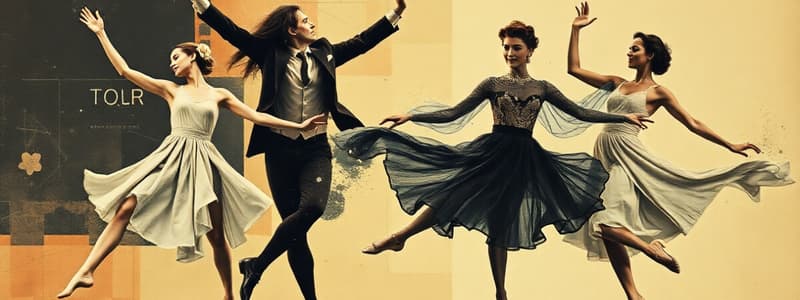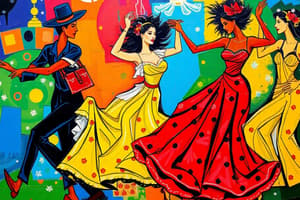Podcast
Questions and Answers
Which dance form originated as a 17th-century Japanese theatrical dance-drama?
Which dance form originated as a 17th-century Japanese theatrical dance-drama?
- Coppélia
- Viennese Waltz
- Love, the Magician
- Kabuki (correct)
Which musical piece is most famously associated with the Viennese Waltz?
Which musical piece is most famously associated with the Viennese Waltz?
- El amor brujo
- The Nutcracker
- Coppélia
- "On the Beautiful Blue Danube" (correct)
Léo Delibes is best known as the composer of which ballet?
Léo Delibes is best known as the composer of which ballet?
- The Sleeping Beauty
- Swan Lake
- Coppélia (correct)
- Giselle
In Kabuki performances, who traditionally performs all roles, including female characters?
In Kabuki performances, who traditionally performs all roles, including female characters?
Love, the Magician (El amor brujo) is best described as a piece inspired by which dance style?
Love, the Magician (El amor brujo) is best described as a piece inspired by which dance style?
The Viennese Waltz became popular as a ballroom dance in which century?
The Viennese Waltz became popular as a ballroom dance in which century?
Which of the following best describes the narrative style of the ballet Coppélia?
Which of the following best describes the narrative style of the ballet Coppélia?
The music for Love, the Magician (El amor brujo) is characterized by its adaptation for which ensemble?
The music for Love, the Magician (El amor brujo) is characterized by its adaptation for which ensemble?
Flashcards
Viennese Waltz
Viennese Waltz
An 18th-century ballroom dance for two, featuring turning movements.
'On the Beautiful Blue Danube'
'On the Beautiful Blue Danube'
A famous waltz by Johann Strauss II often associated with the Viennese Waltz.
Coppélia
Coppélia
A 1870 ballet about a mechanical doll, blending humor with energetic dances.
Character dances
Character dances
Signup and view all the flashcards
Love, the Magician
Love, the Magician
Signup and view all the flashcards
Kabuki
Kabuki
Signup and view all the flashcards
Flamenco
Flamenco
Signup and view all the flashcards
Ballroom dance
Ballroom dance
Signup and view all the flashcards
Study Notes
Dazzling Dances
- Music has inspired dancing since people could use simple instruments or voices to create rhythm.
- Dances have varied styles, costumes, steps, and techniques from the Romantic waltz to the energetic Irish dance.
- Different dance styles use different musical instruments, single or full orchestras.
Coppélia
- Composed by Léo Delibes (1870).
- Includes a humorous story about a mechanical doll.
- Contains energetic national dances and character dances.
- Moved away from fashionable, romantic ballet of the time.
Viennese Waltz
- 18th century ballroom dance.
- Performed by two people turning and turning around each other.
- While different music can be used, "On the Beautiful Blue Danube" (1866) by Johann Strauss II is a famous example.
Kabuki
- 17th-century Japanese theatrical dance-drama.
- Male actors portray both male and female roles.
- Costumes are elaborate, makeup is bright.
- Music has ever-changing rhythms, using instruments and voices.
Love, the Magician (El amor brujo)
- Composed by Manuel de Falla (1915).
- Originally written for flamenco dance.
- Story involves a Spanish Gypsy girl haunted by her dead husband.
- The music is used in flamenco dance and is adapted for symphony, an orchestra, and ballet.
- Shows a fire dance with her husband's ghost, and when she dances, the ghost disappears.
Studying That Suits You
Use AI to generate personalized quizzes and flashcards to suit your learning preferences.




